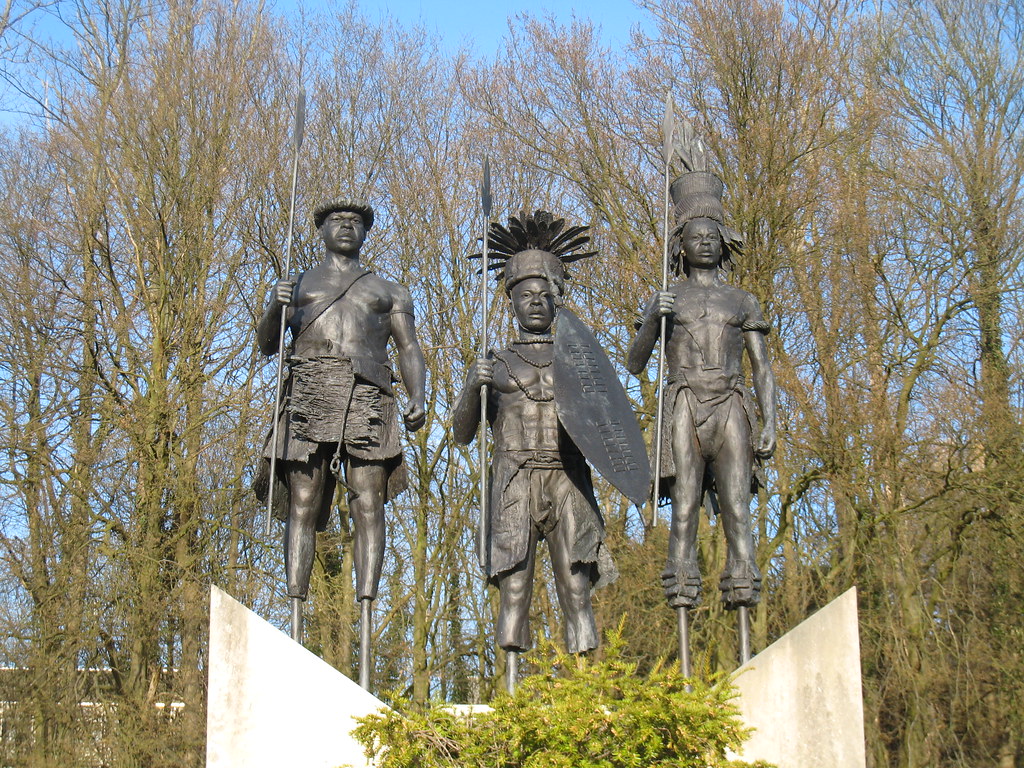By Joshua I. Cohen /Africa as a Country/ – The notion of “the anxiety of influence,” theorized in the 1970s by the conservative American literary critic Harold Bloom, now stands to be reconfigured as a means of contesting the same Western canon that Bloom worked so tirelessly to defend.
When it comes to Africa and the West, there is perhaps no better-known case of influence than that of Pablo Picasso. During the years leading up to and through the development of Cubism, Picasso first unexpectedly encountered, and then systematically studied and collected, a limited corpus of African sculptural objects. These diverse objects variously informed, among other works, Picasso’s landmark painting Les Demoiselles d’Avignon (1907), and his first three-dimensional Guitar (1912), a seemingly slapdash but equally groundbreaking constructed sculpture made of paperboard, twine, and adhesives.
Recent international debates have queried the status of African artworks displaced under colonial occupation, including those seen by Picasso in Paris. Meanwhile, a longer-running debate—and a more rarified one—has examined the status of 20th century African modernists, including their complex relationships to modernisms in the West.
As I argue in a new book, artistic influence carries its own political stakes, which are particularly relevant within institutional spaces where African cultures get represented: exhibitions, university curricula, the media, among others. This is what I’m calling “the politics of influence.” If influence didn’t have a politics, then people like Harold Bloom probably wouldn’t have bothered getting involved.
For African and modern art, one notorious Bloom-like figure was William Rubin, who in 1967 became curator at New York’s Museum of Modern Art (MoMA). The analogy to Bloom is not entirely apt, as the two men’s roles, tastes, and trajectories differed. One thing they certainly shared, though, was their own outsized anxieties about influence.
Rubin also shared this with his friend Picasso, who was infamously quoted in 1920 as saying, “L’art nègre? Connais pas!” (“Black art? Never heard of it!”) Whether or not the Spanish artist ever actually uttered these words, the statement was tongue-in-cheek: Parisians already knew how much the artist was beholden to African and Oceanic sculpture, labeled in early 20th century France as “art nègre.” Later Picasso disavowed “Black” influence much more cunningly, either by shifting attention toward ancient Iberian stone sculpture (another influence), or by referencing the perceived psycho-spiritual power of African objects. The artist never spoke directly of his formal appropriations.
Rubin would follow the painter’s lead. After organizing a giant Picasso retrospective at MoMA in 1980, the curator again made Picasso the protagonist of a blockbuster survey called “’Primitivism’ in 20th Century Art: Affinity of the Tribal and the Modern” (1984). In principle, this exhibition set out to acknowledge modernist borrowings from so-called primitive or tribal art (a dubious category, carried over from the 19th century, encompassing indigenous material culture from Africa to the South Pacific and the Americas). In practice, Rubin and his collaborators downplayed non-Western formal influence at every turn.
They did this by using two key terms, “primitivism” and “affinity,” to frame European artists’ engagements with non-Western arts as chance encounters (not colonially determined ones), and then to reinscribe non-Western traditions as “primitive” (not modern). Within MoMA’s galleries, these rhetorical moves permitted the curators to misuse art history’s visually-based methods by arbitrarily juxtaposing modernist and so-called tribal pieces whose striking formal resemblances belied their historical incongruity: European artists had not necessarily seen the particular “tribal” works on display. This rendered the whole question of influence as moot. Modernist debts became mystical “affinities,” while non-Western contexts were summarily dismissed, quite ironically, as irrelevant to questions of form.
None of this went over well in 1984. Edward Said had already published Orientalism, and critics were increasingly attuned to the erasures of indigenous cultures and colonial legacies that routinely took place under cover of modernism. “Primitivism,” which was widely scorned, marked an art-historical turning point—a critical shift toward postcolonialism.
What surprised me in the 2010s, as I was researching my book, was the way the post-1984 generation ended up regarding African sculptural influence as: 1) vitally important, especially for dismantling persistent notions of Western cultural supremacy and originality; but also as 2) a foregone conclusion, such that Rubin’s method of arbitrary formal comparison would perpetually return. Although “primitivism” had failed, the exhibition’s formalist methodology triumphed, and the conceptual framework of “primitivism” was retrofitted in the image of Orientalism, albeit with a crucial difference. Whereas Said’s Orientalism would mutate in the work of later scholars, “primitivism” seemed hardly to depart from Said’s original schema, portraying colonialism as a neat oppositional binary wherein only the colonizer ever commands power and attention.
My own work responds to this state of affairs by carefully documenting the presence of African sculptural elements within modernism, and by equally prioritizing considerations of Afro-modernist engagements with African canonical sculpture. Throughout the book’s trajectory—from the Fauves and Picasso to the Harlem Renaissance, and from the work of South African artist Ernest Mancoba to Negritude and the École de Dakar—African sculptural influence re-emerges as both eminently knowable and globally significant.
To assail the nagging category of “primitive” art, the book’s research highlights the tumultuous conditions of African colonial modernity under which certain influential African sculptural objects came into being and credits the agency of African cultural producers within those contexts.
The book also aims to modify accounts of African and diaspora modernisms wherever they risk reformulating colonial-era expectations of either authentic “native” autonomy or hopelessly compromised cultural assimilation. It takes Afro-modernist appropriative practices as sites of double-citation—referencing both African sculptural works and the ghosts of Europe’s avant-gardes—in which African and diaspora artists ultimately manage to snatch “influence” away from its presumptive associations with complete unoriginality, and convert it, instead, into something to be actively negotiated and strategically entertained.






